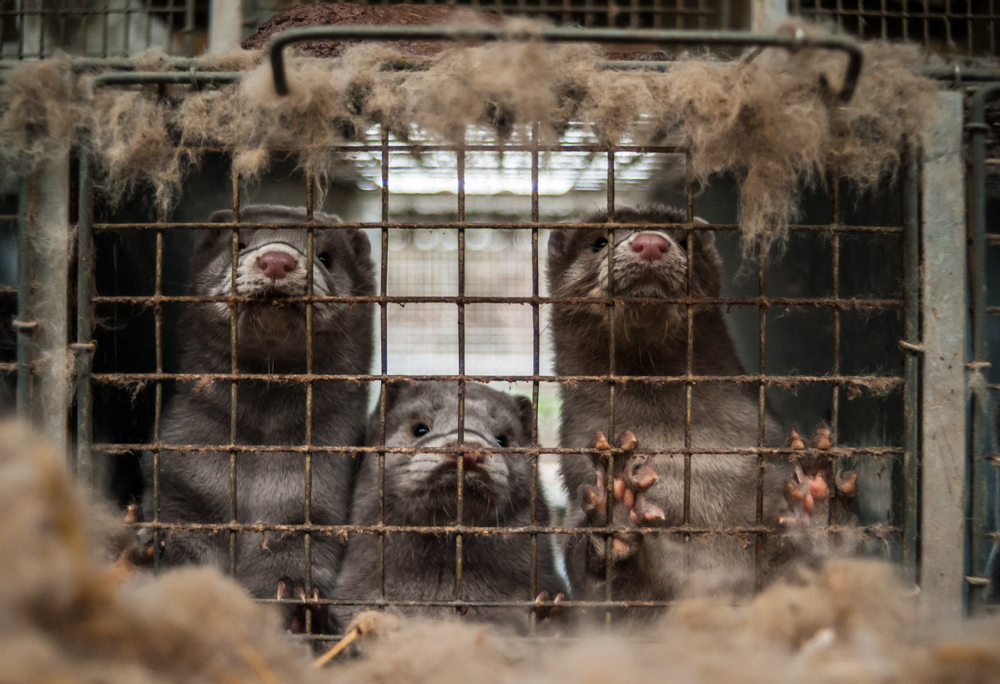Norway Has Officially Ended Fur Farming for Good – Farms Were Given Until February 2025 to Shut Down

Picture this: A creature born to roam, to hunt, to feel the earth beneath its paws. Instead, it spends its entire life in a metal cage, pacing, waiting—until one day, it doesn’t.
For decades, that was the reality of Norway’s fur industry. Thousands of minks and foxes, trapped in a system built on the illusion of luxury. Fur coats draped over shoulders, fashion runways glittering with the price of their suffering.
But here’s the thing about progress—it doesn’t care about tradition. It challenges us to ask: Do we still need this? Can we do better?
Norway just answered that question. The country has officially banned fur farming, giving farmers until February 2025 to shut down operations. A nation once home to nearly 300 fur farms is now turning the page.
How Norway Woke Up to the Cruelty of Fur Farming
 Image Source: Shutterstock
Image Source: Shutterstock
Norway’s decision to end fur farming didn’t happen overnight—it was the result of years of growing public awareness, political debate, and undeniable evidence of animal suffering. For decades, fur farming was a part of the country’s agricultural landscape, with mink and fox farms scattered across rural areas. At its peak, Norway housed nearly 300 fur farms, exporting pelts to high-end fashion markets worldwide.
But as the world evolved, so did attitudes toward fur. The tide began to turn in the early 2000s, when hidden-camera investigations revealed disturbing footage from Norwegian fur farms—animals pacing frantically in cramped cages, injured from self-mutilation or attacks from cage mates, their psychological stress evident. These images sparked outrage, forcing the public and policymakers to confront an uncomfortable truth: fur farming wasn’t just outdated, it was inhumane.
Animal rights organizations, including the Norwegian Society for the Protection of Animals and international groups like PETA, played a crucial role in raising awareness. Their campaigns pressured lawmakers to take action, and the evidence was impossible to ignore. A government-appointed commission in 2014 even concluded that fur farming was inconsistent with modern animal welfare standards.
Public sentiment shifted rapidly. By 2018, a survey showed that the majority of Norwegians supported banning fur farming entirely. That same year, the government announced its decision: fur farming would be phased out completely, with a final deadline set for February 2025. Now, as that deadline approaches, Norway is making history—choosing ethics over tradition and setting a precedent for other nations to follow.
The Moral Reckoning Behind Norway’s Fur Ban
 Image Source: Shutterstock
Image Source: Shutterstock
At the heart of Norway’s fur farming ban lies a fundamental question: Should fashion justify suffering? For decades, fur was marketed as a luxury—soft, warm, and elegant. But behind the glossy magazine spreads and designer runways, the reality was far from glamorous.
Animals bred for fur—mostly mink and foxes—lived in conditions that starkly contrasted with their natural instincts. In the wild, foxes roam vast territories, and mink are semi-aquatic creatures that thrive near lakes and rivers. On fur farms, however, their lives were confined to small, barren cages, barely large enough to turn around in. Deprived of stimulation, many exhibited extreme distress, gnawing at their own limbs, pacing repetitively, or fighting each other in overcrowded conditions. Investigations repeatedly uncovered animals with untreated wounds, missing ears, or open sores, left in agony until they were ultimately killed—often by gassing or electrocution.
The ethical concerns surrounding fur farming weren’t just emotional arguments; they were backed by science. Veterinary and animal welfare experts consistently found that no humane method existed to farm fur-bearing animals at an industrial scale. Reports highlighted that the intense confinement and unnatural environment led to chronic stress, weakened immune systems, and severe behavioral abnormalities. Organizations such as the Norwegian Veterinary Association took a firm stance against the practice, reinforcing what activists had long argued: that fur farming was incompatible with modern animal welfare standards.
Beyond the ethical implications, the industry also faced a growing moral reckoning among consumers. The fur trade, once a symbol of wealth and status, began to lose its appeal. Public attitudes shifted as people questioned whether luxury should come at the cost of immense animal suffering. Norway’s ban wasn’t just about shutting down an industry—it was about redefining values, acknowledging that in a society that champions compassion and sustainability, fur had no place.
How Norway Is Handling the Transition
Banning fur farming was a victory for animal rights, but for those whose livelihoods depended on the industry, it also presented a major upheaval. Norway’s fur farmers—many of whom had inherited their businesses through generations—were faced with a difficult transition. With nearly 200 active fur farms still in operation at the time of the ban, the question became: What happens to the people who relied on this industry to make a living?
Recognizing the economic impact, the Norwegian government introduced a compensation plan to help farmers transition to other livelihoods. The plan, which allocated over 500 million Norwegian kroner (approximately $50 million USD), aimed to support former fur farmers in shutting down their operations and finding new sources of income. Some transitioned to traditional livestock farming, while others explored alternative industries such as tourism or renewable energy. However, not all farmers accepted the decision without resistance. Lawsuits were filed, with some arguing that the government’s compensation was insufficient, considering the financial losses and emotional toll of closing multi-generational businesses.
Beyond the farmers, the ban also affected those indirectly linked to the industry—fur processors, suppliers, and even international fashion markets that sourced Norwegian pelts. While the fur industry had been shrinking for years due to declining demand, the official ban marked the final blow. Major luxury brands had already been distancing themselves from fur, and Norway’s decision reinforced the growing global trend.
Despite these challenges, the transition reflects a broader shift in how societies weigh economic interests against ethical considerations. Governments worldwide have often been hesitant to ban industries with deep-rooted financial ties, fearing job losses and backlash. Norway’s approach—offering financial support while standing firm on the ethical necessity of the ban—could serve as a model for other countries considering similar policies.
Norway Is Just the Beginning—The Countries Pushing Fur into the Past
 Image Source: Pexels
Image Source: Pexels
Norway’s decision to ban fur farming isn’t happening in isolation—it’s part of a growing global movement. Over the past two decades, several countries have recognized that fur belongs in the past, not in fashion. Nations such as the United Kingdom, Austria, the Netherlands, and Belgium have already outlawed fur farming, while others, like France and Italy, have imposed restrictions or bans on specific species. Even in places where fur farming is still legal, the industry is rapidly shrinking as public opinion and corporate policies shift toward ethical alternatives.
One of the strongest indicators of this shift is the stance taken by major fashion brands. Once synonymous with high-end luxury, fur is now being phased out by some of the biggest names in the industry. Brands like Gucci, Prada, Versace, and Burberry have all pledged to go fur-free, reflecting the changing attitudes of consumers who are increasingly demanding cruelty-free fashion. The rise of high-quality faux fur and sustainable alternatives has further undercut the need for real animal fur, proving that innovation can replace outdated traditions.
Even in countries where fur farming remains legal, the pressure to reform is mounting. The European Union has seen growing calls for a total ban on fur farming, with over 1.5 million people signing the “Fur Free Europe” petition in 2023. In the United States, fur bans have gained traction at the state and local levels, with California becoming the first state to ban fur sales entirely. The trend is clear: the world is moving away from fur, and Norway’s ban is just another milestone in a much larger transformation.
What This Means for the Future of Animal Rights
Norway’s decision isn’t just about fur—it’s about a shift in how we value life.
For centuries, animals have been used for food, fashion, and entertainment, often without question. But now, we’re finally pausing to ask: Is this necessary? Is it ethical? Can we do better?
Norway answered with action, and the world is listening. Fur farming is fading, but what about factory farming? What about animal testing? If we accept that fur coats aren’t worth the suffering behind them, what other industries need to be reexamined?
Change doesn’t happen overnight, but every decision we make shapes the future. The fur industry didn’t fall on its own—people spoke up, consumers made different choices, and governments followed. That same power exists in every movement toward a more compassionate world.
The ripple effect of Norway’s choice extends far beyond its borders. More countries will follow. More industries will be challenged. And one day, we’ll look back at fur farming the same way we now view other outdated cruelties—as something humanity outgrew.
The question is no longer if we can create a more ethical world. It’s when. And more importantly—what’s next?
Featured Image Source: Shutterstock
Loading...






